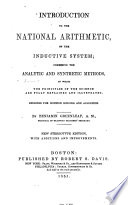 | Benjamin Naylor - 1850 - 334 pages
...the medium time for the payment of the whole debt. From the above illustration we infer the following RULE. Multiply each payment by the time at which it is due, and divide the sum of the products by the sum of the payments, and the quotient will be the equated... | |
 | Charles Davies - Arithmetic - 1850 - 412 pages
...payments.) Hence, to find the mean time, Multiply each payment by the time before it becomes due, and divide the sum of the products by the sum of the payments : the quotient will be the mean time. EXAMPLES. 1. B owes A $600: $200 is to be paid in two months,... | |
 | Benjamin Greenleaf - 1851 - 332 pages
...for the payment of the whole. Hence the following RULE. — Multiply each payment by the time before it is due, then divide the sum of the products by the sum of the payments, and the quotient will be the true time required. NOTE 1. — This is the rule usually adopted by merchants,... | |
 | Daniel Leach - Arithmetic - 1851 - 280 pages
...sums, due at different periods. 244. RULE. Multiply each sum by the time before it becomes due, and divide the sum of the products by the sum of the payments. OBS. 1. This rule has "been considered by many as incorrect ; but it is as correct as any rule founded... | |
 | John Bonnycastle - 1851 - 314 pages
...ingredients are given, to find the value of the compound. RULE.* Multiply each quantity by its rate ; then divide the sum of the products by the sum of the quantities, or the whole composition, and the quotient will be the rate of the compound required. EXAMPLES.... | |
 | Benjamin Greenleaf - Arithmetic - 1852 - 380 pages
...same as $19 for T'F of 152 months, which is 8 months, as before. Hence the propriety of the following RULE.* — Multiply each payment by the time at which...sum of the products by the sum of the payments, and tlie quotient will be the true time required. 2. A owes B $ 300, of which $ 50 is to be paid in 2 'months,... | |
 | Charles Davies - 1852 - 344 pages
...payments.) Hence, to find the mean time, Multiply each payment by the time before it becomes due, and divide the sum of the products by the sum of the payments : the quotient will be the mean time. EXAMPLES. 1. B. owes A $600 ; $200 is to be paid in two months,... | |
 | John Radford Young - Arithmetic - 1852 - 230 pages
...sum by the number of months, or weeks, &c. , which are to elapse before payment is to be made, and then divide the sum of the products by the sum of the bills, the quotient will be what is called the equaled time in which all should be paid if they are... | |
 | Thomas Grainger Hall - 1853 - 268 pages
...different times, may be paid without loss either to the debtor or creditor. Rule. — Multiply each debt by the time at which it is due, then divide the sum of the products by the sum of the debts, and the quotient will be the equated time. Ex. (1.) A owes 5001., 2001. is due at the end of... | |
 | Daniel Leach - Arithmetic - 1853 - 622 pages
...sums, due at different periods. 244. RULE. Multiply each sum by the time before it becomes due, and divide the sum of the products by the sum of the payments. OBS. 1 . This rule has been considered by many as incorrect ; but it is as correct as any rule founded... | |
| |